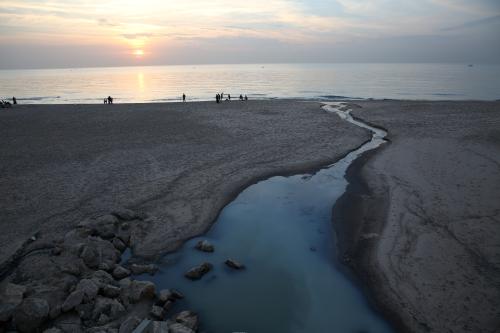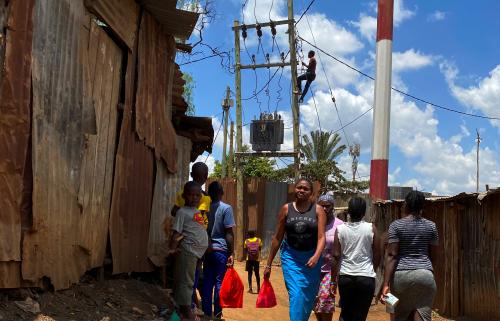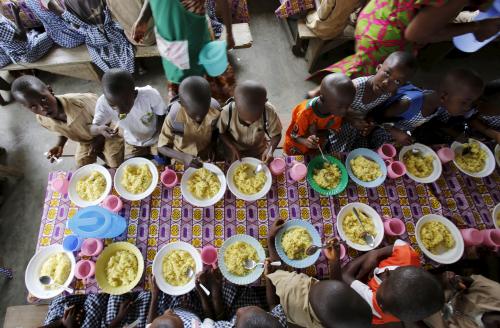Is energy the “golden thread” that connects economic growth, social equity, and environmental sustainability? To answer this question, the Sustainable Energy Transitions Initiative (SETI) set up a systematic review and searched through nearly 77,500 papers over three years. Professor Marc Jeuland and Jonathan Phillips will be summarizing the findings of this new study on energy access and the internationally agreed Sustainable Development Goals (SDGs) at the fourth Sustainable Energy for All forum.
What has SETI found and why should you care? While we know how energy access impacts many of the SDGs, we don’t have enough scientific evidence about what is being done by practitioners and policymakers in low- and middle-income countries. This “know-do gap”—what we know through research and what is implemented—will keep the world from achieving a critical cluster of SDGs.
What SETI did
The search combined three groups of broadly specified terms: 1) low- and middle-income countries country/region, 2) energy technology or fuel, and 3) impacts or energy-use-related descriptors. SETI scholars identified nearly 77,500 articles across multiple academic publications databases, and then screened and double-screened these for relevance based on title and abstract reviews. Ultimately, roughly 10 percent—still a large number of about 8,000 articles—were retained for detailed coding. The SETI team assessed relevance with the consideration of the social dimensions of energy. The analyses focus primarily on the quantitative impact studies.
Figure 1: Number of articles included in the review, by (left) country focus and (right) year of publication
While there has been a burst of energy research in low- and middle-income countries in the past decade, geographic coverage is patchy. Most large countries are well represented, but some such as Indonesia are not. And lower-income countries in sub-Saharan Africa—ground zero for energy poverty—get less attention than they should.
In general, this review points to a troubling pattern: A big gap between what is being evaluated by scholars and the types of programs, projects, and policies being implemented. These know-do gaps take different forms—the interventions implemented are often not the ones studied, the intended impacts are not the impacts studied, and the geographical areas studied do not fully represent the areas of implementation.
Know-do gaps emerge largely because impact evaluations are public goods; that is, because it rarely makes sense for an organization to conduct an expensive impact evaluation that will not directly benefit the project. Besides, there are large differences between evidentiary standards and the research needs of policymakers and researchers. And inevitably, there isn’t enough local capacity to conduct serious evaluations.
If we don’t make scientific evidence much more practice based by encouraging (rigorous-enough) impact evaluations of real-life projects, programs, and policies, we will continue to be in the dark.
What we do know
The SETI review is both systematic and broad and utilizes an “energy services framework” designed to better understand how energy relates to the welfare of end-users. This is what we know:
- Energy access threads though many development goals. Improved energy access can be mapped to at least nine SDGs: poverty (#1); hunger (#2); health (#3); education (#4); gender equality (#5); work (#8); industry (#9); innovation (#10); climate (#13); and land use (#15)—see Figure 2a.
- But the energy thread is not always golden. As shown in Figure 1a, energy transitions might sometimes reduce air quality, hurt health, and harm the climate and forest ecosystems.
- The golden parts of the thread are thin. While some technologies such as as solar (Figure 2b) are consistently more golden, they are a small fraction of the scientific impact studies. This reflects the small share of solar energy in overall generation.
Figure 2: The effects of energy interventions

- Energy for cooking is the favorite subject of study. Scholars and funders play favorites—they have been studying cooking services zealously, especially at the household level and on cooking-health-air-quality interactions.
- Studies on poverty reduction look as much at lighting and heating as cooking. Research on poverty reduction is more evenly spread across the energy services for cooking, lighting, and heating. Firm level studies naturally look at impacts on production and profits; the few studies on GDP almost always look at industrial energy use.
Our biggest blind spots
The SETI review finds that we know very little about the impacts on gender equity and public services such as health care and schooling; agriculture and service sectors, relative to manufacturing and industry; forests and ecosystems, relative to air quality and climate forcing; and solar (both off- and mini-grids), wind, micro-hydro, and biogas.
For example, few (just 67) quantitative studies demonstrate the role of energy in affecting gender equity. Eighty-five percent of these studies focused on cooking services; fewer studies considered lighting (22 percent) and heating (19 percent). Within the relatively large body of interdisciplinary literature on the effects of energy services on household health (438 unique studies), approximately 80 percent of studies focus on cooking, followed by heating (24 percent) and then lighting (11 percent). Far fewer (just 16) consider the impacts of energy on health facilities.
Given all the commotion about solar and other renewables, human capital, and inclusion, these are serious blind spots.
Closing the energy access know-do gap
The SETI review took stock of the research on energy access and energy transitions in low- and middle-income countries. What it found indicates a serious need for research aligned with on-the-ground needs and our ultimate goal of ending energy poverty. Energy might be a golden thread, but this hasn’t yet been proven in a scientific setting. The SETI review threads the needle for closing the know-do gap in places where it matters most. To do this, the global community must:
- Build local research capacity
- Crowd in new funds for research, which are essentially international public goods
- Above all, have scholars and practitioners jointly own and produce applied research that avoid type 3 errors—precise answers to pointless questions.
Of course, all such research on impacts of energy access must be combined with studies of the drivers of energy access—that is, finance, market development (including consumer demand), programming, and regulations.
In short, a lot of stitching still has to be done by researchers and practitioners who care about energy and development.










Commentary
Achieving universal energy access by closing the gap between what we know and what we do
May 1, 2018